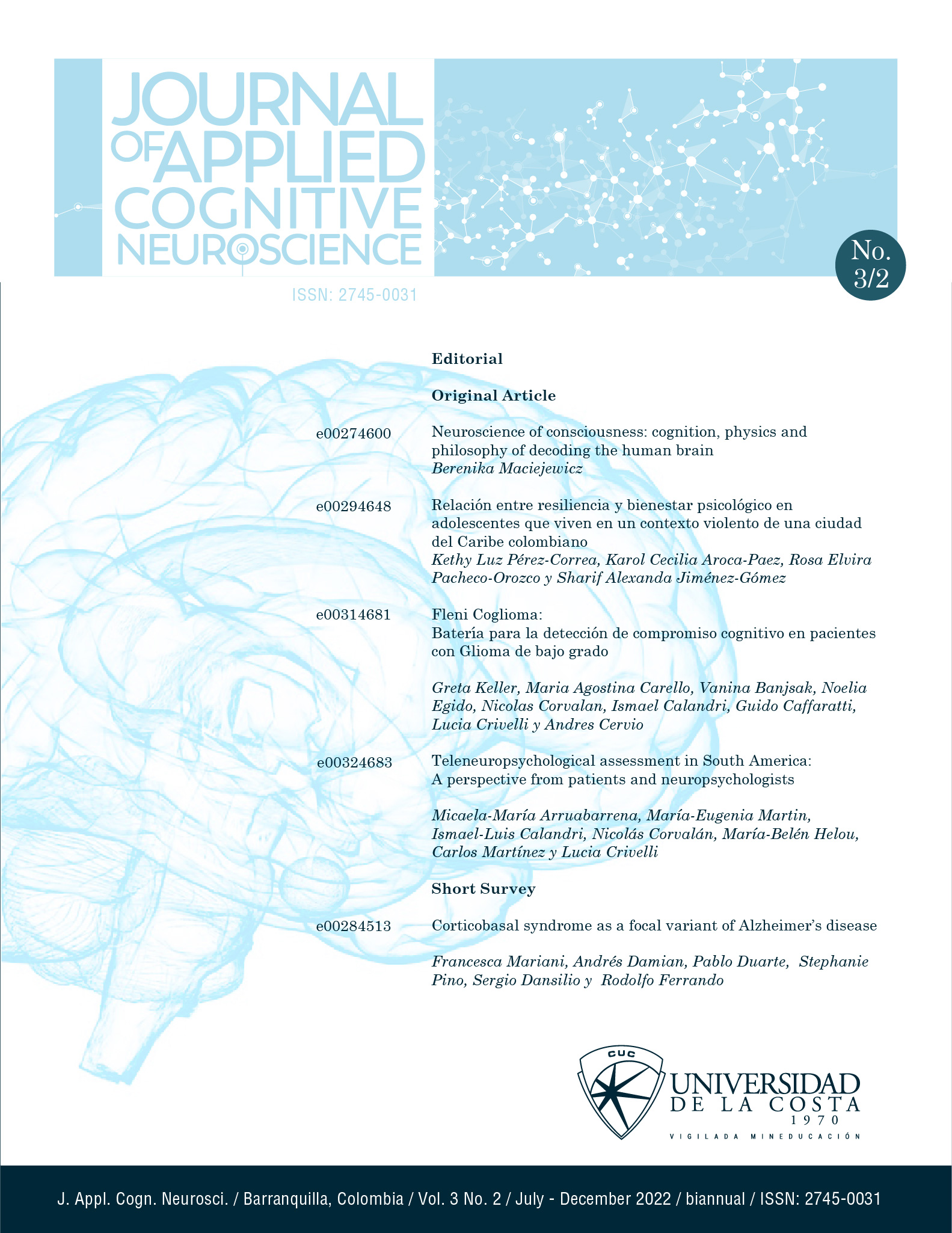Neuroscience of consciousness: cognition, physics and philosophy of decoding the human brain
Neurociencia de la conciencia: cognición, física y filosofía de la descodificación del cerebro humano
DOI:
https://doi.org/10.17981/JACN.3.2.2022.02Palabras clave:
neuroscience of consciousness, self-awareness, conscious awareness, consciousness, cognitionResumen
The biophysical roots of consciousness have been the subject of an ongoing debate for centuries. In order to understand the data, create novel experimental methodologies, and increase our ability to investigate this phenomenon of interest, the proposed theories must lead to empirical, repeatable, and testifiable studies. Contemporary theories of consciousness often do not relate to one another, and none of them has been distinguished as complete or proven empirically so far. The aim of this study is an investigation into some of the possible approaches that could merge neuronal brain activity with the laws of physics and some philosophical principles that may be associated with the emergence of consciousness in the first place. As a result, the relationship between consciousness and attention, working memory, access consciousness and phenomenal consciousness is evaluated. The contrast between conscious and unconscious perception, perceived visual inputs and subliminal ones is investigated to facilitate a discussion about the neural correlates of self-awareness. Consciousness as a global broadcast of information to integrated brain modules is being considered, as well as viewing a brain as a parallel information processor linked to attention inputs. Relationship between consciousness and attention is explored, as well as attention without consciousness and vice versa. Implications and shortcomings of the proposed approaches based on brain science, philosophy and quantum physics are also covered to shed some more light on this ever present experience of being conscious that everyone seems to self-witness but no one manages to adequately explain.
Descargas
Citas
Baars, B. J. (1993). A cognitive theory of consciousness. (pp. xxiii, 424). Cambridge University Press.
Baddeley, A. D. (2007). Working memory, thought, and action. Oxford University Press.
Berkeley, G. (1948). In AA Luce, & TE Jessop. In A. A. Luce & T. E. Jessop (Eds.), The Works of George Berkeley, Bishop of Cloyne (p. 9). Thomas Nelson.
Blackmore, S. J., & Troscianko, E. (2018). Consciousness: An introduction (3rd edition). Routledge.
Block, N. (1995). On a confusion about a function of consciousness. Behavioral and Brain Sciences, 18(2), 227–247. https://doi.org/10.1017/S0140525X00038188
Block, N. J. (1982). Functionalism. In Studies in Logic and the Foundations of Mathematics (Vol. 104, pp. 519–539). Elsevier. https://doi.org/10.1016/S0049-237X(09)70217-4
Carr, B. J., & Rees, M. J. (1979). The anthropic principle and the structure of the physical world. Nature, 278(5705), 605–612. https://doi.org/10.1038/278605a0
Chalmers, D. (2015). Panpsychism and Panprotopsychism.Consciousness in the physical world: Perspectives on Russellian monism. Amherst Lecture in Philosophy, 8.
Chalmers, D. J. (1996). The conscious mind: In search of a fundamental theory. Oxford University Press.
Chalmers, D. J., & Chalmers, D. (1999). Materialism and the Metaphysics of Modality. Philosophy and Phenomenological Research, 59(2), 473. https://doi.org/10.2307/2653685
Dehaene, S. (2014). Consciousness and the brain: Deciphering how the brain codes our thoughts. Viking.
Dehaene, S., Changeux, J.-P., Naccache, L., Sackur, J., & Sergent, C. (2006). Conscious, preconscious, and subliminal processing: A testable taxonomy. Trends in Cognitive Sciences, 10(5), 204–211. https://doi.org/10.1016/j.tics.2006.03.007
Dennett, D. C., & Weiner, P. (1993). Consciousness explained. Penguin Books.
Descartes, R. (1641). Meditations On First Philosophy.
Goodale, M. A., & Milner, A. D. (1992). Separate visual pathways for perception and action. Trends in Neurosciences, 15(1), 20–25. https://doi.org/10.1016/0166-2236(92)90344-8
Goswami, A. (1995). The self-aware universe: How consciousness creates the material world. Penguin Publishing Group.
Koch, C., & Tsuchiya, N. (2007). Attention and consciousness: Two distinct brain processes. Trends in Cognitive Sciences, 11(1), 16–22. https://doi.org/10.1016/j.tics.2006.10.012
Kolers, P. A., & von Grünau, M. (1976). Shape and color in apparent motion. Vision Research, 16(4), 329–335. https://doi.org/10.1016/0042-6989(76)90192-9
Li, F. F., VanRullen, R., Koch, C., & Perona, P. (2002). Rapid natural scene categorization in the near absence of attention. Proceedings of the National Academy of Sciences, 99(14), 9596–9601. https://doi.org/10.1073/pnas.092277599
Libet, B., Wright, E. W. W., Feinstein, B., & Pearl, D. K. (1979). Subjective referral of the timing for a conscious sensory experience: a functional role for the somatosensory specific projection system in man. Brain, 102(1), 193–224. https://doi.org/10.1093/brain/102.1.193
Montemayor, C., & Haladjian, H. H. (2015). Consciousness, attention, and conscious attention. The MIT Press.
Prinz, J. J. (2012). The conscious brain: How attention engenders experience. Oxford University Press.
Reddy, L., Reddy, L., & Koch, C. (2006). Face identification in the near-absence of focal attention. Vision Research, 46(15), 2336–2343. https://doi.org/10.1016/j.visres.2006.01.020
Shoemaker, S. (1982). The Inverted Spectrum. The Journal of Philosophy, 79(7), 357. https://doi.org/10.2307/2026213
Simons, D. J., & Levin, D. T. (1997). Change blindness. Trends in Cognitive Sciences, 1(7), 261–267. https://doi.org/10.1016/S1364-6613(97)01080-2
Treisman, A., & Schmidt, H. (1982). Illusory conjunctions in the perception of objects. Cognitive Psychology, 14(1), 107–141. https://doi.org/10.1016/0010-0285(82)90006-8
Weiskrantz, L., Warrington, E. K., Sanders, M. D., & Marshall, J. (1974). VISUAL CAPACITY IN THE HVisual capacity in the hemianopic field following a restricted occipital ablation. Brain, 97(1), 709–728. https://doi.org/10.1093/brain/97.1.709
Wigner, E. P. (1995). Remarks on the Mind-Body Question. In J. Mehra (Ed.), Philosophical Reflections and Syntheses (pp. 247–260). Springer Berlin Heidelberg. https://doi.org/10.1007/978-3-642-78374-6_20
Descargas
Publicado
Cómo citar
Número
Sección
Licencia
Derechos de autor 2022 Journal of Applied Cognitive Neuroscience

Esta obra está bajo una licencia internacional Creative Commons Atribución-NoComercial-SinDerivadas 4.0.
Usted es libre de:
1. Compartir - copiar y redistribuir el material en cualquier medio o formato.
2. El licenciante no puede revocar estas libertades siempre que usted respete los términos de la licencia.
Bajo los siguientes términos:
1. Atribución - Usted debe dar el crédito apropiado, proporcionar un enlace a la licencia, e indicar si se hicieron cambios. Puede hacerlo de cualquier manera razonable, pero no de forma que sugiera que el licenciante le respalda a usted o a su uso.
2. NoComercial - No puede utilizar el material con fines comerciales.
3. NoDerivados - Si remezcla, transforma o construye sobre el material, no puede distribuir el material modificado.
4. Sin restricciones adicionales - Usted no puede aplicar términos legales o medidas tecnológicas que restrinjan legalmente a otros de hacer cualquier cosa que la licencia permita.


 English
English
 Español (España)
Español (España)










